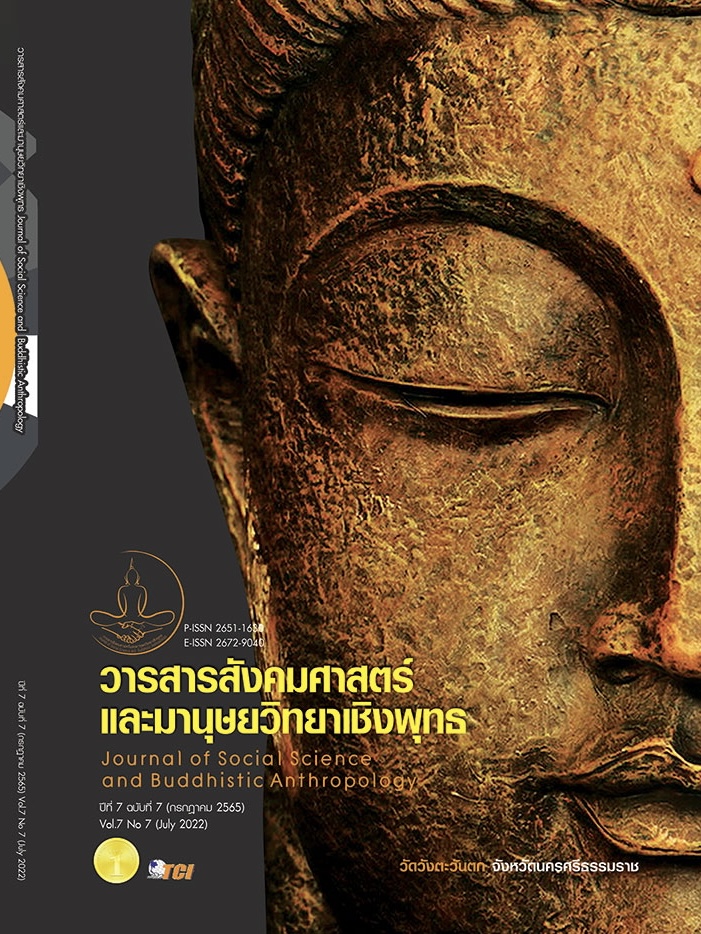NEEDS AND GUIDELINES OF THE INTEGRATIVE PHYSICAL ACTIVITY TO ENHANCING EXECUTIVE FUNCTIONS OF EARLY CHILDHOOD IN SURIN PROVINCE
Keywords:
Integrative Physical Activity, Executive Functions, Early ChildhoodAbstract
The Objectives of this research article were to study conditions, problems, needs, and guidelines for the development of the integrative physical activity to enhance executive functions of early childhood in Surin province. This synthesis and survey research was conducted to obtain the information necessary for the development of the integrative physical activity. Data were collected from 3 parts as follows. 1) The study about conditions and problems in organizing physical activities - the participants of this part of research consisted of 9 teachers and 9 school administrators where data were collected through an interview. A content analysis was applied to form an inductive summary. 2) The study about the needs for the integrative physical activities - there were 330 teachers participated in this part of the study. Data were collected through a questionnaire and the collected data was analyzed for the modified priority needs index (PNIModified). 3) The study about guidelines to develop the integrative physical activity - there were 6 experts participated according to this part of the study. Data were collected through an interview. A content analysis was applied to form an inductive summary. The study found that: 1) According to conditions and problems in organizing the physical activity, the physical activities are organized together with outdoor and movement activities. In addition, there is not a wide variety of physical activities and lack of processes to enhance executive functions. 2) In term of the needs for the integrative physical activity, the most essential need is the learning process (PNIModified = 0.17). 3) Owing to the guidelines for the development of the integrative physical activity, it is recommended that the physical activity should be divided into 3 levels: Level 1 - teaching basic movement skills corresponding to the activity; Level 2 - practicing with increased physical exertion with a movement to assemble equipment; Level 3 - challenging where obstacles or conditions for children to plan to solve the problem. Physical activities should be designed for both individual and group play and should be organized 3 times a week about 50 - 60 minutes each time.
References
กระทรวงศึกษาธิการ. (2560). หลักสูตรการศึกษาปฐมวัย พุทธศักราช 2560 : สำนักวิชาการและมาตรฐานการศึกษา, สำนักงานคณะกรรมการการศึกษาขั้นพื้นฐาน. กรุงเทพมหานคร: โรงพิมพ์ชุมนุมสหกรณ์การเกษตรแห่งประเทศไทย จำกัด.
กระทรวงสาธารณสุข. (2560). แผนแม่บทการส่งเสริมกิจกรรมทางกาย พ.ศ. 2561-2573. กองกิจกรรมทางกายเพื่อสุขภาพ กรมอนามัย. เรียกใช้เมื่อ 9 พฤศจิกายน 2564 จาก https://dopah.anamai.moph.go.th/th/activity-plan/download/?did= 185662&id=16955&reload=
จิระพร ชะโน. (2562). การคิดเชิงบริหารกับการพัฒนาเด็กปฐมวัย. วารสารศึกษาศาสตร์มหาวิทยาลัยมหาสารคาม, 13(1), 7-17.
ธิติ ญานปรีชาเศรษฐ. (2564). กิจกรรมทางกายช่วยเพิ่มความจำและผลสัมฤทธิ์ทางวิชาการ. วารสารศึกษาศาสตร์ มหาวิทยาลัยศิลปากร, 19(2), 45-52.
นวลจันทร์ จุฑาภักดีกุล และคณะ. (2560). การพัฒนาและหาค่าเกณฑ์มาตรฐานเครื่องมือประเมินการคิดเชิงบริหารในเด็กปฐมวัย. (พิมพ์ครั้งที่ 1) . กรุงเทพมหานคร : ศูนย์วิจัยประสาทวิทยาศาสตร์สถาบัน ชีววิทยาศาสตร์โมเลกุล มหาวิทยาลัยมหิดล.
พาสนา จุลรัตน์. (2561). การจัดการเรียนรู้สำหรับผู้เรียนในยุคThailand 4.0. วารสารมหาวิทยาลัยศิลปากร, 11(2), 2363-2380.
เพิ่มศักดิ์ สุริยจันท. (2557). การสร้างสนามเด็กเล่นกลางแจ้ง ตามแนวคิดปัญญา. ใน เอกสารประกอบการประชุมผู้บริหารสถานศึกษาและครูพลศึกษา ตามโครงการส่งเสริมกิจกรรมทางกายสำหรับนักเรียนโรงเรียนตำรวจตระเวนชายแดนและโรงเรียนในถิ่นทุรกันดารกันยายน-ตุลาคม 2557. มหาวิทยาลัยราชภัฏเชียงใหม่.
เยาวพา เดชะคุปต์. (2542). การศึกษาปฐมวัย. กรุงเทพมหานคร: แม็ค.
ศรีเรือน แก้วกังวาล. (2549). จิตวิทยาพัฒนาการชีวิตทุกช่วงวัย (พิมพ์ครั้งที่ 9) . กรุงเทพมหานคร: สำนักพิมพ์มหาวิทยาลัยธรรมีศาสตร์.
สถาบันราชานุกูล กรมสุขภาพจิต. (2559). คู่มือการจัดกิจกรรมการเสริมสร้างความผูกพัน ทางอารมณ์สำหรับพ่อแม่หรือผู้เลี้ยงดูเด็กวัยแรกเกิด 5 ปี ด้วย "กิน กอด เล่น เล่า". (พิมพ์ครั้งที่ 2). กรุงเทพมหานคร : โรงพิมพ์ชุมนุมสหกรณ์การเกษตรแห่งประเทศไทย จำกัด.
สถาบันวิจัยประชากรและสังคม มหาวิทยาลัยมหิดล. (2562). โครงการพัฒนาต้นแบบส่งเสริมการเล่นในบริบทไทยเพื่อสร้างทักษะสำหรับเด็กและเยาวชน : THAI-ACP. นครปฐม: มหาวิทยาลัยมหิดล.
สุวิมล ว่องวาณิช. (2558). การวิจัยประเมินความต้องการจำเป็น (พิมพ์ครั้งที่ 3). กรุงเทพมหานคร: สำนักพิมพ์แห่งจุฬาลงกรณ์มหาวิทยาลัย.
อรุณี หรดาล. (2563). สอนอย่างไรให้เด็กปฐมวัยคิดเป็น. วารสารวไลยอลงกรณ์ปริทัศน์ (มนุษยศาสตร์และสังคมศาสตร์), 10(2), 221-228.
อัจฉรียา กสิยะพัท. (2563). ผลของโปรแกรมการส่งเสริมกิจกรรมทางกายสำหรับนักเรียนปฐมวัยอายุ 2-5ปีที่มีต่อการพัฒนาสมรรถภาพทางกาย อารมณ์จิตใจ สังคม และปัญญา เพื่อนำไปสู่การมีความสามารถในการปฏิบัติกิจกรรมทางกาย. วารสารวิจัยราชภัฏเชียงใหม่, 21(3), 49-67.
Di Liegro, C.M et al. (2019). Physical Activity and Brain Health. Genes, 10(9), 720-733.
Eric R. Kandal. et al. (2012). Principles of Neural Science. by McGraw-Hill: Fifth.
Hötting, K., & Röder, B. (2013). Beneficial effects of physical exercise on neuroplasticity andcognition. Neuroscience & Biobehavioral Reviews, 37 (9, Part B), 2243-2257.
Hughes, C. & Ensor, R. (2007). Executive function and theory of mind: Predictive relationsfrom ages 2 to 4. Developmental psychology, 43(6), 1447-1460.
Cabe, M. C. et al. (2004). The development of self-regulation in young children: Individualcharacteristics and environmental contexts. In R. F. Baumeister & K. D. Vohs (Eds.),Handbook of self-regulation : Research, theory, and applications. (pp. 340). NewYork : United States.
McClelland, M. M. et al. (2006). The impact of kindergarten learning - related skills onacademic trajectories at the end of elementary school. Early Childhood Research Quarterly, 21(4), 471–490.
Miller, E. K. & Cohen, J. D. (2001). An integrative theory of prefrontal cortex function. Annual Review of Neuroscience, 24(1), 167-202.
Roebers, C. M. et al. . (2011). Schoolenrolment and executive functioning: A longitudinalperspective on developmental changes,the influence of learning context, and the prediction of pre- academic skills. EuropeanJournal of Developmental Psychology, 8(5), 526-540.
Swanson, H. L. et al. (2008). Growth in working memory and mathematical problem solvingin children at risk and not at risk for serious math difficulties. Journal of educationalpsychology, 100(2), 343-358.
World Health Organization. (2019). Guidelines on physical activity, sedentary
behaviour andsleep for children under 5 years of age. Geneva: World Health Organization.
Downloads
Published
How to Cite
Issue
Section
License
Copyright (c) 2022 Journal of Social Science and Buddhistic Anthropology

This work is licensed under a Creative Commons Attribution-NonCommercial-NoDerivatives 4.0 International License.








